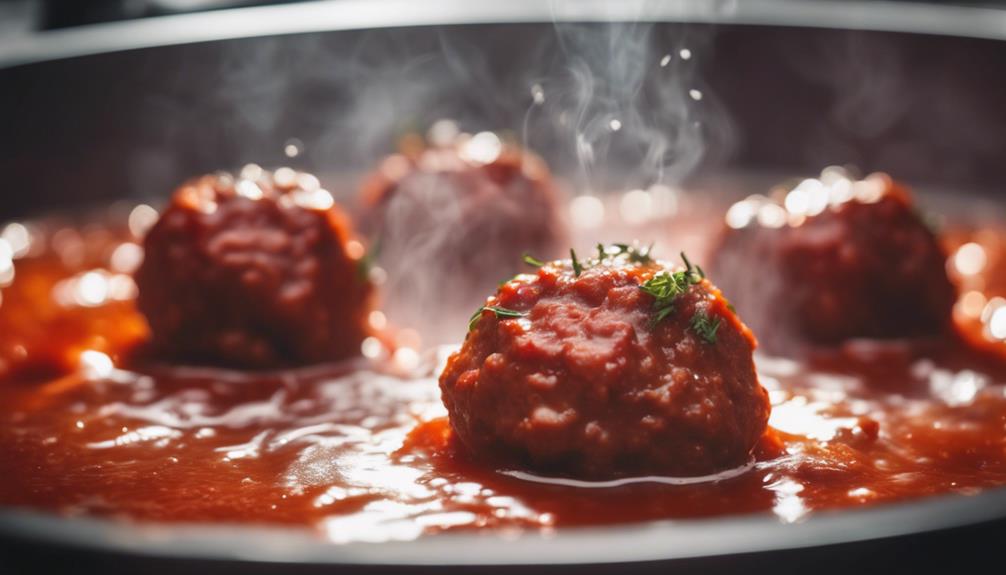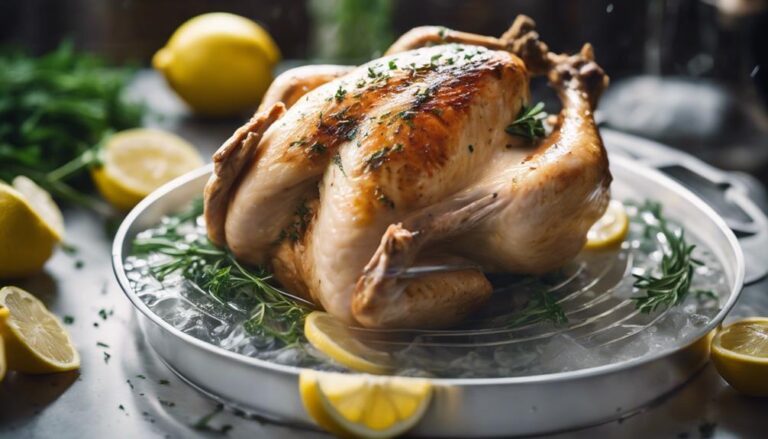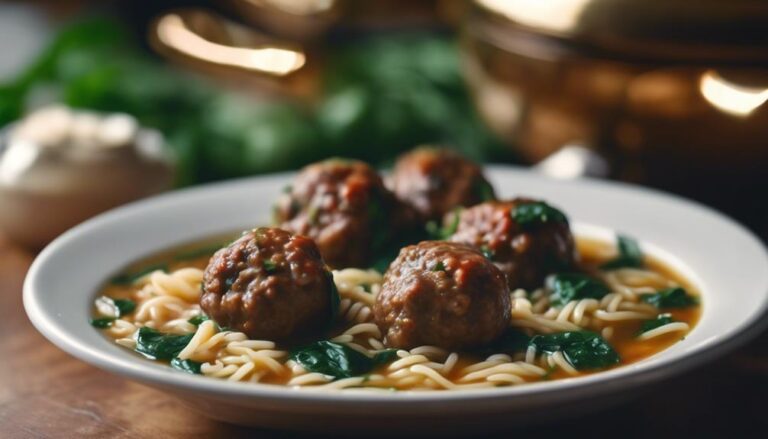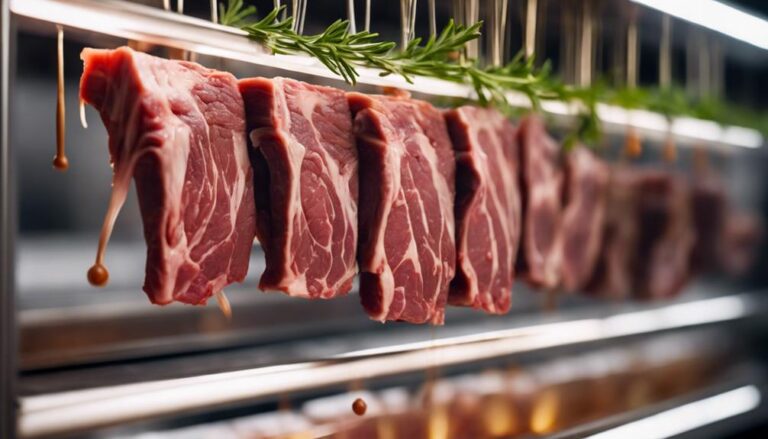Sous Vide Meatball Marinara
For a superb meatball marinara, try sous vide cooking. This method guarantees tender, succulent meatballs paired with a rich marinara sauce that's bursting with flavor. The precise temperatures of sous vide fusion meld the tastes impeccably, offering an elevated dining experience. Get ready to savor every bite of this culinary masterpiece.
What You Will Learn Here
- Sous vide technique enhances marinara flavors
- Juicy and succulent meatballs preserved
- Controlled temperature prevents overcooking
- Complex marinara sauce developed
- Precision cooking elevates dish quality
Meatball Origins
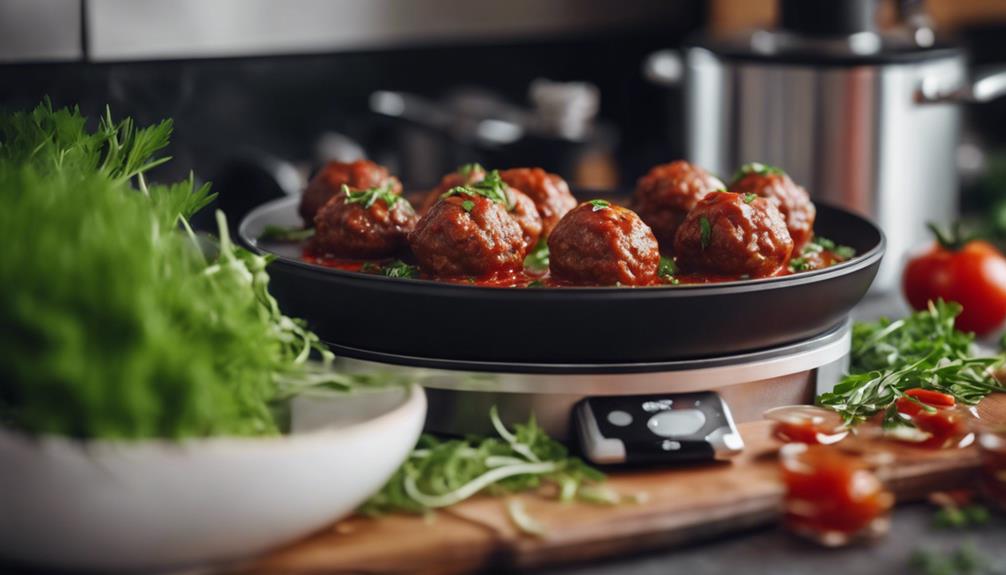
Meatballs have a rich history that traces back to various cultures and regions around the world. By exploring traditional meatball recipes, one can uncover the unique and diverse ways in which this dish has been prepared over the centuries.
Understanding the evolution of meatballs sheds light on how this beloved food has adapted and transformed through time.
Meatball History
With origins dating back to ancient Rome, the history of meatballs can be traced through various cultures and cuisines. Meatball origins can be found in multiple traditional recipes worldwide, showcasing the versatility of this beloved dish.
In Italy, meatballs, known as 'polpette', are typically made with a combination of ground meats, breadcrumbs, herbs, and cheese. Similarly, Swedish meatballs are seasoned with spices like allspice and nutmeg, served with a creamy gravy. Greek meatballs, or 'keftedes', often include a mix of ground lamb or beef with herbs like mint and oregano.
Each culture has put its unique spin on the meatball, demonstrating how this simple yet flavorful dish has evolved over centuries.
Traditional Meatball Recipes
Tracing back through various cultures and cuisines, the origins of meatballs offer a fascinating glimpse into the diverse traditional recipes that have evolved over time.
In Italy, meatballs, known as 'polpette,' are typically presented as small, round balls made from a mixture of ground meat, breadcrumbs, and seasonings, often served in a rich tomato sauce.
Swedish meatballs, on the other hand, are shaped into larger, tender spheres, seasoned with spices like allspice and nutmeg, and commonly paired with lingonberry sauce.
Greek meatballs, or 'keftedes,' are often flavored with herbs like mint and oregano, and served with tzatziki sauce.
For a classic presentation, meatballs can be garnished with fresh herbs like parsley and paired with pasta, mashed potatoes, or crusty bread.
Evolution of Meatballs
The evolution of meatballs can be observed by examining the diverse cultural influences and culinary traditions that have shaped these iconic dishes over time. Meatball innovations have led to a wide array of flavors and textures, reflecting the creativity and adaptability of different cultures. From the traditional Italian meatballs to Swedish köttbullar, each variation showcases unique ingredients and cooking methods that have evolved over centuries. Cultural influences play a significant role in shaping meatball recipes, with each region adding its own twist to create a distinct culinary identity. Modern twists on classic meatballs incorporate global ingredients and cooking techniques, resulting in a fusion of flavors that cater to contemporary palates.
| Meatball Innovations | Evolution of Flavors |
|---|---|
| Italian Polpette | Tomato-based sauces |
| Swedish Köttbullar | Lingonberry jam |
| Middle Eastern Kofta | Spices like cumin |
| Asian Pork Balls | Soy sauce glazes |
Key Meatball Components

To create exceptional meatballs, understanding the essential components is important. When crafting the perfect meatball, two key aspects to take into account are meatball texture and meatball seasoning.
- Meatball Texture: Achieving the ideal texture for your meatballs is essential. You want them to be tender and moist, yet still hold their shape. This can be achieved by using a combination of ground meats with varying fat percentages. Adding breadcrumbs soaked in milk or broth can also help maintain moisture and prevent the meatballs from becoming too dense.
- Meatball Seasoning: Seasoning is what elevates a basic meatball to a flavorful delight. A blend of salt, pepper, garlic, onion powder, and fresh herbs like parsley or basil can add depth to the meatball mixture. Don't forget to taste the mixture before forming the meatballs to make sure the seasoning is just right.
Meatball Variations
You can explore a range of meatball variations to suit different tastes and preferences. Consider trying:
- A savory Italian meatball recipe for a classic flavor profile.
- A spicy turkey meatball recipe for a kick of heat.
- A mouthwatering Swedish meatball recipe for a rich and creamy option.
Each variation offers a unique twist on the traditional meatball, providing a diverse culinary experience for you to enjoy.
Savory Italian Meatball Recipe
Consider enhancing the flavor profile of your meatball dish by incorporating a variety of savory Italian-inspired variations. Italian meatballs offer a rich and robust taste that can elevate your meal to the next level. Here are some ideas to help you create delicious savory Italian meatballs:
- Meatball Pairing Ideas:
- Serve the meatballs with al dente spaghetti and a sprinkle of Parmesan cheese for a classic combination.
- Pair the meatballs with creamy polenta and a side of roasted vegetables for a hearty and fulfilling meal.
- Create a meatball sub by placing the meatballs in a crusty Italian roll with marinara sauce and melted mozzarella cheese.
These variations won't only add depth of flavor but also impress your guests with an authentic Italian dining experience.
Spicy Turkey Meatball Recipe
Exploring the fiery flavors of a spicy turkey meatball recipe can provide a zesty twist to your traditional meatball repertoire. When preparing this dish, consider incorporating these spicy meatball alternatives and turkey meatball seasonings to elevate the heat and flavor profile:
- Substitute ground turkey for beef to create a leaner option with a milder flavor.
- Add cayenne pepper or red pepper flakes for a kick of heat that complements the turkey's natural taste.
- Experiment with spices like cumin, paprika, and garlic powder to enhance the savory elements of the meatballs.
These adjustments can transform your meatball experience, infusing it with a bold and spicy twist that will tantalize your taste buds.
Mouthwatering Swedish Meatball Recipe
For those interested in a delectable twist on traditional meatball recipes, explore the flavors of a mouthwatering Swedish Meatball recipe, known for its savory richness and unique blend of spices. When preparing this dish, consider the following:
- Swedish Meatball Pairing: These delectable meatballs are often paired with lingonberry jam or cranberry sauce to balance the savory flavors with a touch of sweetness.
- Meatball Seasoning Secrets: The key to achieving the signature taste of Swedish meatballs lies in the seasoning. A blend of spices like allspice, nutmeg, and a hint of cardamom elevates the flavor profile to create a truly unforgettable dish.
- Texture Matters: To achieve the perfect texture, a mixture of ground beef and pork is often used, along with breadcrumbs and milk soaked together before forming the meatballs.
Meatball Cooking Techniques
When preparing meatballs, the cooking techniques play a vital role in achieving the desired texture and flavor.
Start by rolling the meatball mixture into evenly sized balls to guarantee even cooking.
Browning the meatballs before finishing them by baking or simmering will enhance the Maillard reaction and develop a rich, savory taste.
Rolling Meatball Mixture
To shape the meatball mixture, gently roll portions of the mixture between your palms into evenly sized spheres. The mixing technique used before rolling plays an important role in the texture and flavor of the meatballs. Guarantee the ingredients are evenly distributed throughout the mixture to prevent uneven cooking.
Whether you choose to oven bake or stovetop sear the meatballs, uniformity in size will promote even cooking. Rolling the mixture into consistent spheres not only aids in even cooking but also enhances the presentation of the final dish. Taking care during this step ensures that the meatballs cook uniformly, providing a delicious eating experience.
Consistency in size also helps with portion control and ensures that each meatball is cooked to perfection.
Browning Meatballs Before
After rolling the meatball mixture into evenly sized spheres, the next step involves browning the meatballs before cooking them through using your preferred method. Browning meatballs is an important step in developing rich flavor profiles.
The browning technique you choose can greatly impact the final taste of the meatballs. Pan-searing the meatballs in a hot skillet with a bit of oil creates a caramelized exterior that adds depth and complexity to the dish. This Maillard reaction, where proteins and sugars react under high heat, leads to the development of savory flavors.
Make sure the skillet is hot before adding the meatballs to achieve a nice sear without overcooking the interior. Experiment with different browning times to find your preferred level of flavor development.
Baking or Simmering
For best results when cooking meatballs, consider utilizing the baking or simmering techniques to guarantee even cooking and flavor infusion.
Baking vs. Simmering
When it comes to cooking meatballs, both baking and simmering have their advantages. Baking is a dry-heat method that cooks the meatballs evenly and allows for browning on the outside. On the other hand, simmering involves cooking the meatballs in a liquid like marinara sauce, which can enhance the flavor and keep the meatballs moist.
Flavor Enhancements
| Technique | Advantages | Disadvantages | Best Used For |
|---|---|---|---|
| Baking | Even cooking, browning on the outside | Can dry out meatballs if overcooked | When a crispy exterior is desired |
| Simmering | Flavor infusion, moisture retention | Longer cooking time, meatballs can be delicate | When a more tender texture is preferred, and for flavor-packed meatballs |
Final Thoughts
In concluding this culinary journey with the sous vide meatball marinara, consider the harmonious blend of flavors and textures achieved through this precise cooking method. The final thoughts on this dish revolve around the depth of flavor profiles that the sous vide technique guarantees.
By sealing the ingredients in a vacuum-sealed bag and cooking them in a water bath at a consistent low temperature, the meatballs absorb all the spices and herbs, resulting in a rich and robust taste that permeates each bite. The prolonged cooking time allows the flavors to meld together, creating a well-rounded and complex marinara sauce that perfectly complements the tender meatballs.
Furthermore, the sous vide method ensures that the meatballs maintain their juiciness and succulence, elevating the overall dining experience. The controlled temperature prevents overcooking, preserving the natural juices and yielding a moist and flavorful outcome. This attention to detail in cooking not only enhances the taste but also guarantees a consistently delightful texture in every mouthful.
Ultimately, the sous vide meatball marinara exemplifies how precision cooking techniques can elevate a classic dish to new heights of culinary excellence.
Frequently Asked Questions
Can I Use Frozen Meatballs for This Recipe?
Yes, you can use frozen meatballs for the recipe. Insure proper defrosting for even cooking and best meatball texture. Adjust cooking time slightly if needed. Experiment with different flavor variations and sauce options for a personalized touch.
What Is the Recommended Serving Size for This Dish?
For ideal portion control, consider serving sizes according to your dietary needs. Leftovers can be stored for meal prep. Nutritional information can guide you in balancing your intake. Follow recommended portions for a balanced diet.
Can I Substitute Beef With Other Types of Meat?
You can substitute beef with various meats for meatball variations. Try ground turkey, chicken, or pork. Adjust cooking techniques accordingly to guarantee proper doneness. Experiment with flavors to create unique and delicious dishes.
How Long Can the Meatballs Be Stored in the Fridge?
You can store meatballs in the fridge for up to 3-4 days. Reheat them by gently simmering in marinara sauce or microwave. Explore flavor variations like turkey or chicken meatballs. Meal prep by making a big batch for quick meals.
Are There Any Vegetarian Alternatives for This Recipe?
Looking for vegetarian alternatives? Consider meatless options like lentil or mushroom meatballs. Lentils offer a hearty texture while mushrooms bring a savory umami flavor. These alternatives can be a delicious twist to your recipe.
Conclusion
To sum up, sous vide meatball marinara offers a tender and flavorful twist on a classic dish. By cooking the meatballs slowly and evenly in a vacuum-sealed bag, the flavors are intensified and the texture is perfectly moist.
This method allows for precise control over the cooking temperature, resulting in consistently delicious meatballs every time.
Whether served with pasta, in a sandwich, or on their own, sous vide meatball marinara is sure to impress your taste buds.
